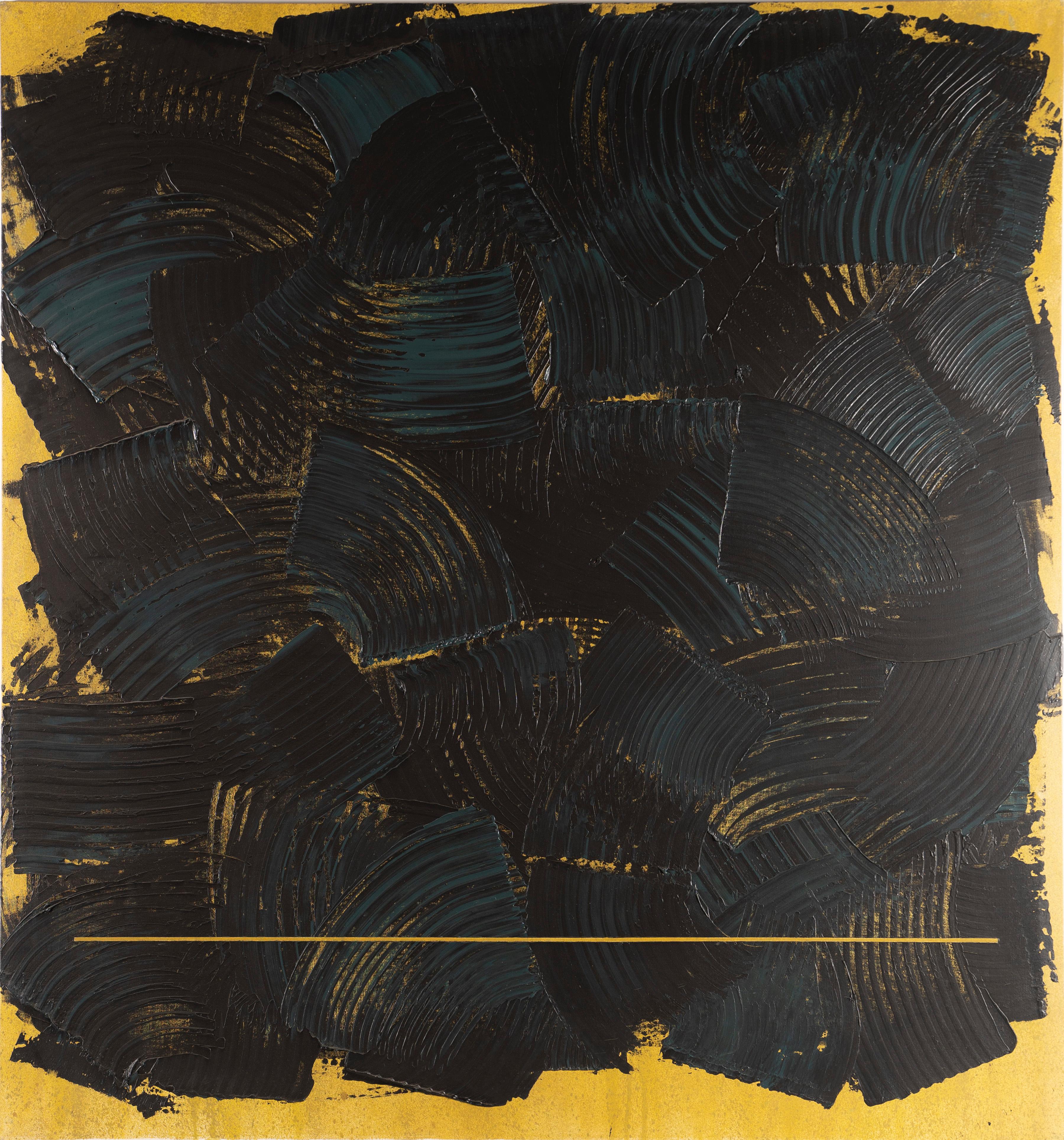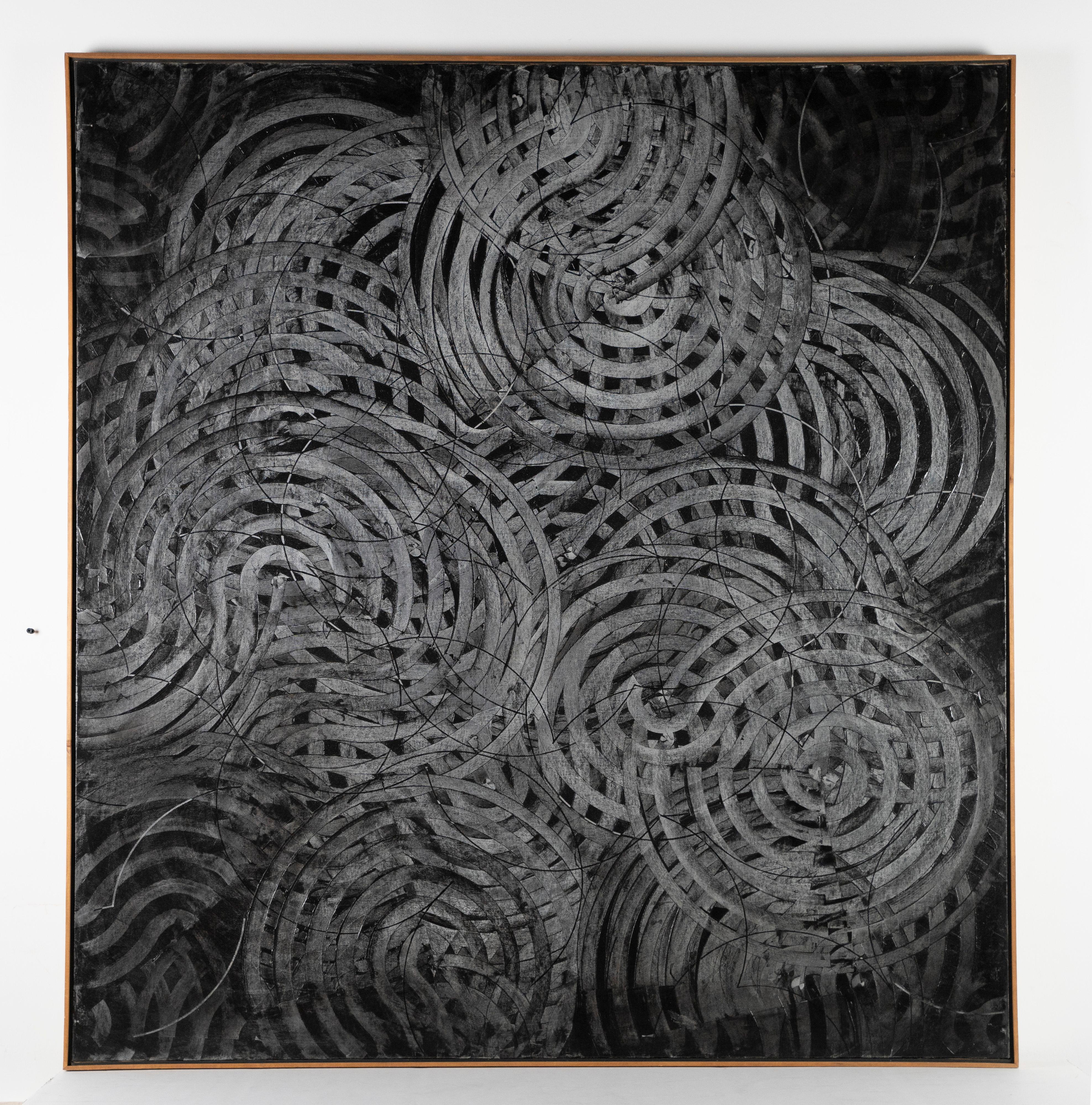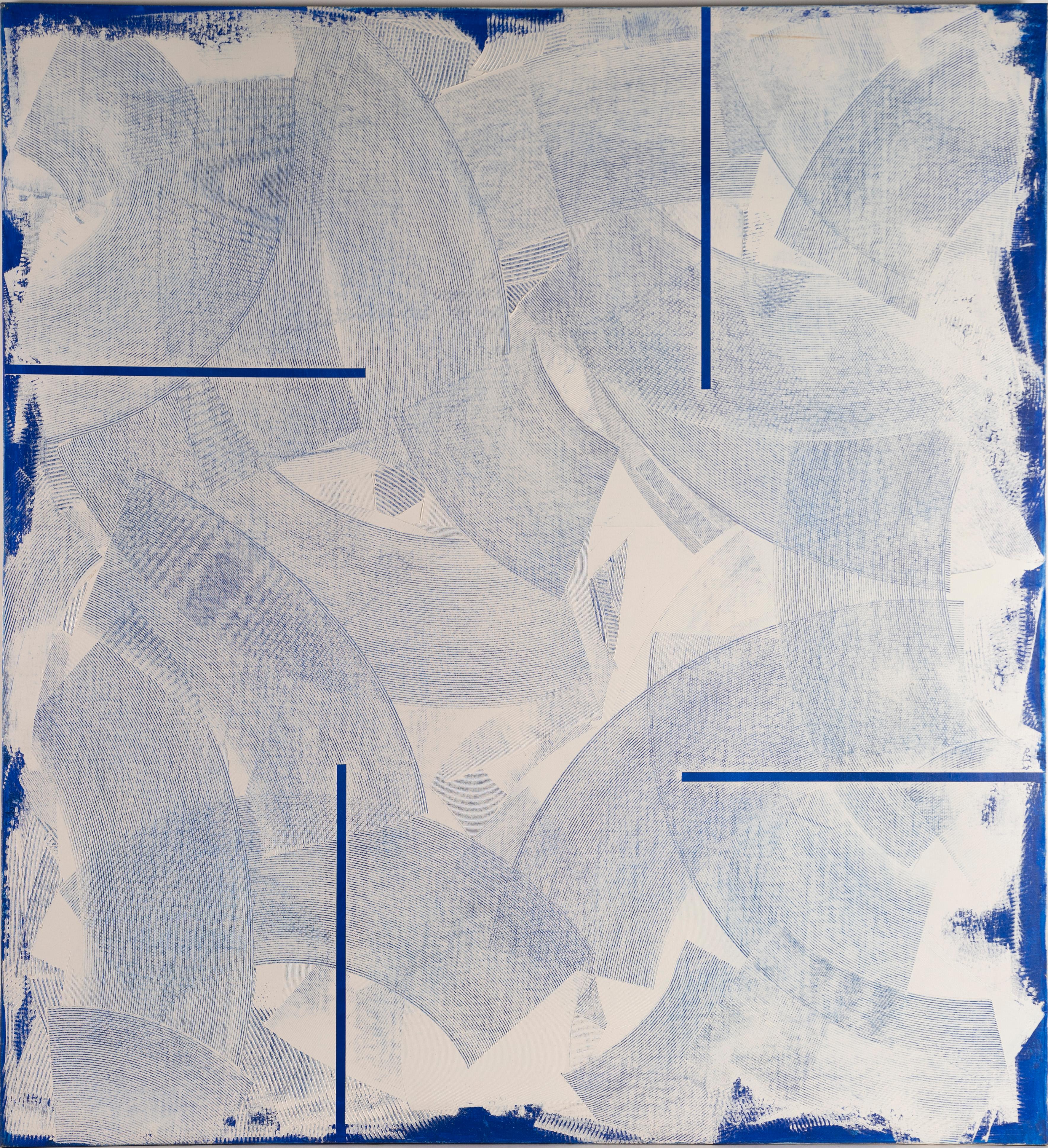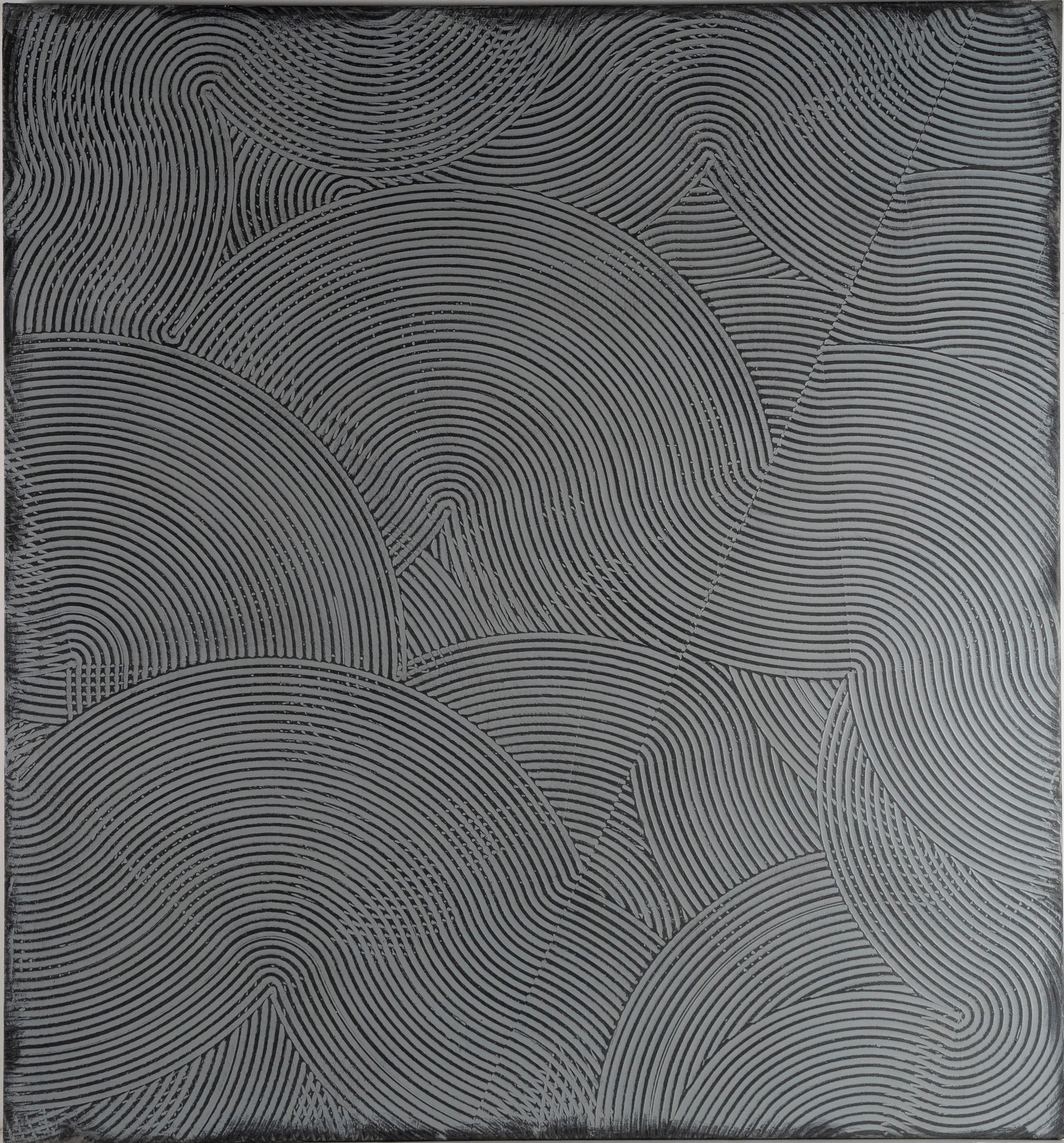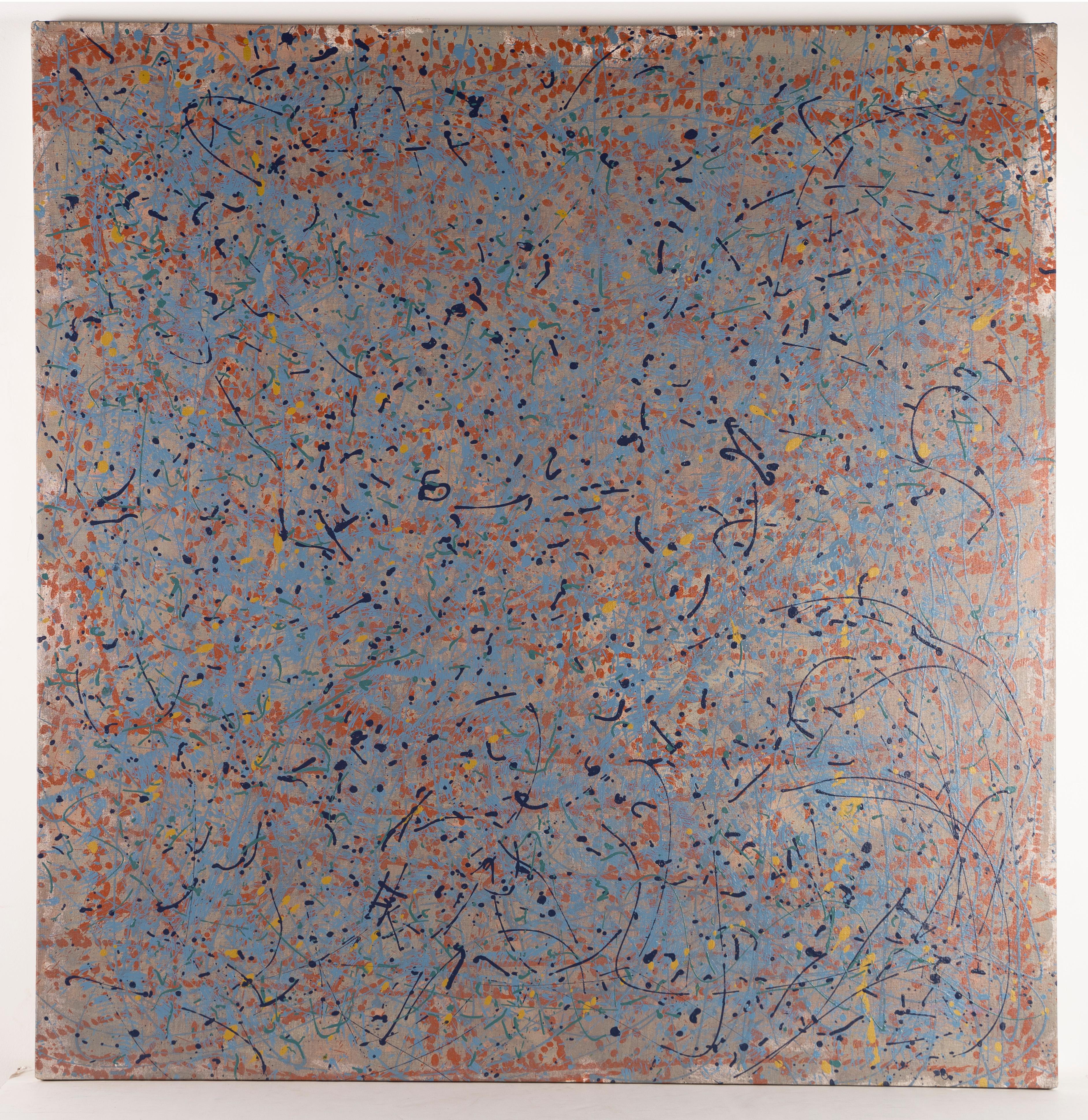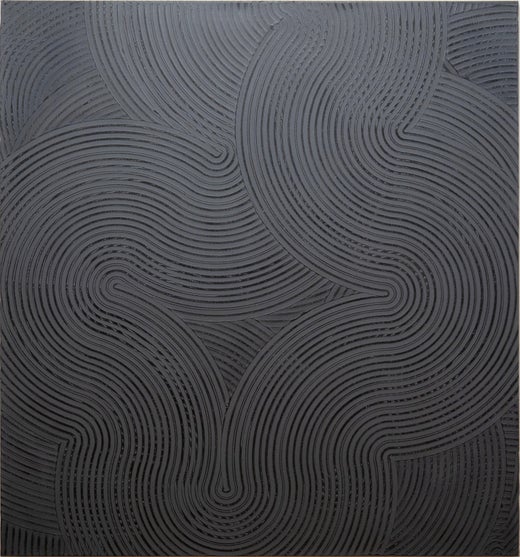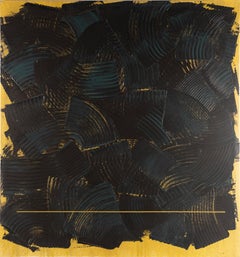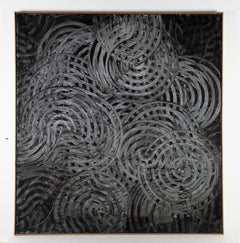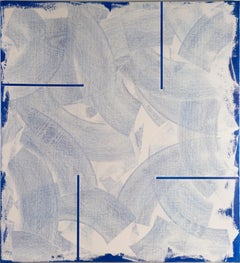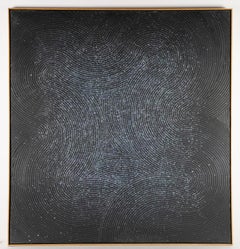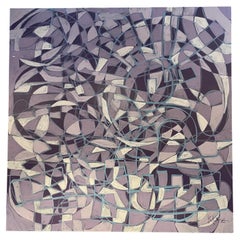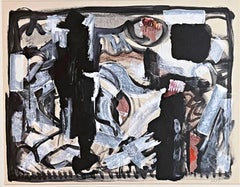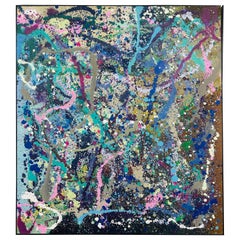Items Similar to Large Mid Century Modern Texas Artist Abstract Expressionist Action Painting
Want more images or videos?
Request additional images or videos from the seller
1 of 14
Duanye HatchettLarge Mid Century Modern Texas Artist Abstract Expressionist Action Painting1990
1990
$3,746.25
$4,99525% Off
£2,827.19
£3,769.5925% Off
€3,236.71
€4,315.6125% Off
CA$5,283.45
CA$7,044.6125% Off
A$5,800.57
A$7,734.1025% Off
CHF 3,026.17
CHF 4,034.9025% Off
MX$70,195.02
MX$93,593.3625% Off
NOK 37,928.37
NOK 50,571.1625% Off
SEK 35,738.49
SEK 47,651.3325% Off
DKK 24,161.16
DKK 32,214.8725% Off
About the Item
An abstract expressionist painting by Duayne Hatchett . Oil on canvas, circa 1990. Signed verso. Framed. I
Duayne Hatchett was a visual artist whose work included prints, paintings, sculpture, and found objects. He was born on May 12, 1925 in Shawnee, Oklahoma. He enlisted in the Air Force where he trained to become a fighter pilot. After leaving the militrary he studied design at the University of Oklahoma. His highly technical military training combined a mathematical intelligence with a love for physics and a daring embrace of new experience, all of which would soon be the tools for his evolution through art.
Two major influences interacted on his early development at OU. Emelio Omero, a colleague and close friend of Diego Rivera, introduced him to the revolutionary art ideas of Mexico City, while teaching him a wide range of printing techniques that would culminate in a Masters Degree in Painting in 1952. During this time he met Bruce Goff, a renowned Wright disciple, who was teaching architecture at OU and befriended Hatchett, introducing him to the most avant-garde architecture of that time.
He spent his summers while at OU designing for a small sign shop, which introduced him to new materials used for building neon, plastic, and metal signs. The use of new materials and a keen sense for design would soon become invaluable building blocks for future sculpture. During this time he met and married Mary Ellen Jeffries. They would spend their lives together and raise three children, David (me), my brother Dana, and my sister Jeffri. As children, they were immersed in art from childhood and benefited greatly from this loving art and domestic environment.
Hatchett was always interested in the techniques of construction, often watching different tradesmen working, understanding how materials are put together to create the manmade environment that surrounded him. While teaching printmaking at Oklahoma City University from 1951 through ‘54, he began to build sculpture employing some of the materials and techniques that he saw workers using. He was beginning to draw the attention of architects and he became interested in their work-trade processes, moving from blue prints to construction. He accepted an invitation from Alexander Hogue to teach sculpture at Tulsa University in 1954. He moved his family to Tulsa where he would teach for the next ten years.
While in Tulsa, he became well known as a teacher and a sculptor, often lecturing at various sculpture conferences around the country. He also began to obtain commissions for sculpture as his interaction with architecture continued to evolve. He began to meet and interact with some of the most influential New York artists, including David Smith, Louise Nevelson, Noguchi, and Chicago artist, Richard Hunt.
The 'found object' became important subject matter for many artists including Hatchett and his frequent trips to junkyards yielded the materials for welded sculptures that explored abstract forms suggestive of the world around him. Sources of inspiration ranged from a dead cat smashed on the road to Sputnik orbiting the earth. Alan Stone Gallery in New York City, arranged to show two of these pieces at the Museum of Modern Art in 1963.
He was offered a teaching job at Ohio State University in 1964, where he would teach sculpture for the next three years, and make a leap of imagination that would propel his art into the museums and galleries in New York City and beyond. He began by moving away from combining found objects to using found materials to fabricate objects that he called "Totems." Royal Marks Gallery in New York City began to represent Hatchett in 1964 and arranged for him to be included in the ‘Young American Sculpture East to West’ show representing the United States in the 1964 New York World’s Fair. He would then leave any hint of the found object or junk material behind (until the 90’s) and move into pure abstraction, what can only be described as 'Modern' Art.
Taking his cue from modern architecture, he began to draw simplified volumes and planes, minimally rendered, so as to be easily grasped as a whole. Built with industrial materials, sheet metals and plastics, the images suggested the look of modern technology and architectural accuracy in the environment. These new works resulted in multiple one-person shows, including shows at Royal Marks Gallery in 1965, ’68, ’69, and ’70, and defined a major shift in his work that would be played out for the next two decades. He was featured on the cover of the Whitney Annual and the Whitney Museum acquired a large sculpture in 1967. He was included in the American Sculpture of the Sixties show at the Los Angeles County Museum and the Pittsburgh International, at the Carnegie Institute Museum of Art that same year.
In 1968 he took a teaching position at the University of Buffalo where he would head the sculpture department for the next 24 years and he would move his art in multiple directions. He began a series of paintings to exploit the simple line drawings previously used to define the plate metal sculpture. These paintings explored the optical relativity of two and three-dimensional space depicted on a flat plane. He was also continuing to develop his geometric minimalist sculptures, landing several sculpture commissions around the country. In 1974, the Albright-Knox Art Gallery in Buffalo, NY presented, Duayne Hatchett: Recent Paintings and Sculpture. In the ensuing years his work would be shown in one person and group shows around the country. In the studio, the confluence of construction and the 'Found Object' re-entered his work in a completely unexpected way. Construction itself became the creative engine transforming his new art.
New tools and working processes were adopted or invented to create new art. The trowel would replace the brush for building new paintings. Tools for rolling and burnishing metal would be invented and riveting would be adopted to build new sculptures. He was influenced by the characteristics of materials and objects such as corrugated sheet metals, the optical effects of plastics, metal grates, tin cans, seen in his man made environment, as well as crosscut tree logs and drift wood from his natural environment. He began to build sculptures, in the privacy of his studio, largely unseen by the public.
In the late 90’s, the found object re-emerged in the form of new sculpture created from railroad spikes welded together to form organic conglomerations reminiscent of nature. He also began to build assemblages of found objects and materials that maintained a continuous flat surface, which were simultaneously sculptures as well as being blocks for prints. By utilizing a wide range of printing techniques that he invented, he made mono-prints that record the image of the assembled material constructions, greatly extending his previous uses of the found object, and greatly expanding the imagery in his printmaking.
From printmaking and painting of the late 40’s, influenced by Mexican Art, through the junk metal used from found objects in the 50’s and early 60’s, through the minimalist sculpture and paintings influenced by modern architecture from the 60’s and 70’s, to the paintings, sculpture and printmaking of the last forty years, Duayne Hatchett has developed a personal expression that solicits a universal response. His unique visual language has been created through the invention of tools, the manipulation of various materials and objects, which he presents in a unified form. These expressions reflect our environment, specifically and generally, as objects once in use or patterns at play. Hatchett’s art works are interactive vessels that hold their content as potential energy, waiting to unlock our memories and our senses through the act of observation.
–David Hatchett, March 2009
Duayne passed away on September 7, 2015.
- Creator:Duanye Hatchett (1925 - 2015, American)
- Creation Year:1990
- Dimensions:Height: 51 in (129.54 cm)Width: 49 in (124.46 cm)Depth: 2 in (5.08 cm)
- Medium:
- Movement & Style:
- Period:
- Framing:Framing Options Available
- Condition:
- Gallery Location:Buffalo, NY
- Reference Number:1stDibs: LU139213565982
Duanye Hatchett
Duayne Hatchett was a visual artist whose work included prints, paintings, sculpture, and found objects. He was born on May 12, 1925 in Shawnee, Oklahoma. He enlisted in the Air Force where he trained to become a fighter pilot. After leaving the military he studied design at the University of Oklahoma. His highly technical military training combined a mathematical intelligence with a love for physics and a daring embrace of new experience, all of which would soon be the tools for his evolution through art. He accepted an invitation from Alexander Hogue to teach sculpture at Tulsa University in 1954. He moved his family to Tulsa where he would teach for the next ten years. While in Tulsa, he became well known as a teacher and a sculptor, often lecturing at various sculpture conferences around the country. He also began to obtain commissions for sculpture as his interaction with architecture continued to evolve. He began to meet and interact with some of the most influential New York artists, including David Smith, Louise Nevelson, Noguchi, and Chicago artist, Richard Hunt. In 1968 he took a teaching position at the University of Buffalo where he would head the sculpture department for the next 24 years and he would move his art in multiple directions. He began a series of paintings to exploit the simple line drawings previously used to define the plate metal sculpture. These paintings explored the optical relativity of two and three-dimensional space depicted on a flat plane. He was also continuing to develop his geometric minimalist sculptures, landing several sculpture commissions around the country. In 1974, the Albright-Knox Art Gallery in Buffalo, NY presented, Duayne Hatchett: Recent Paintings and Sculpture. In the ensuing years his work would be shown in one person and group shows around the country. In the studio, the confluence of construction and the 'Found Object' re-entered his work in a completely unexpected way. Construction itself became the creative engine transforming his new art. New tools and working processes were adopted or invented to create new art. The trowel would replace the brush for building new paintings. Tools for rolling and burnishing metal would be invented and riveting would be adopted to build new sculptures. He was influenced by the characteristics of materials and objects such as corrugated sheet metals, the optical effects of plastics, metal grates, tin cans, seen in his man made environment, as well as crosscut tree logs and drift wood from his natural environment. He began to build sculptures, in the privacy of his studio, largely unseen by the public. In the late 90’s, the found object re-emerged in the form of new sculpture created from railroad spikes welded together to form organic conglomerations reminiscent of nature. He also began to build assemblages of found objects and materials that maintained a continuous flat surface, which were simultaneously sculptures as well as being blocks for prints.
About the Seller
4.9
Gold Seller
Premium sellers maintaining a 4.3+ rating and 24-hour response times
Established in 1970
1stDibs seller since 2015
3,047 sales on 1stDibs
Typical response time: 4 hours
- ShippingRetrieving quote...Shipping from: Brooklyn, NY
- Return Policy
Authenticity Guarantee
In the unlikely event there’s an issue with an item’s authenticity, contact us within 1 year for a full refund. DetailsMoney-Back Guarantee
If your item is not as described, is damaged in transit, or does not arrive, contact us within 7 days for a full refund. Details24-Hour Cancellation
You have a 24-hour grace period in which to reconsider your purchase, with no questions asked.Vetted Professional Sellers
Our world-class sellers must adhere to strict standards for service and quality, maintaining the integrity of our listings.Price-Match Guarantee
If you find that a seller listed the same item for a lower price elsewhere, we’ll match it.Trusted Global Delivery
Our best-in-class carrier network provides specialized shipping options worldwide, including custom delivery.More From This Seller
View AllLarge Mid Century Modern Texas Artist Abstract Expressionist Action Painting
By Duanye Hatchett
Located in Buffalo, NY
An abstract expressionist painting by Duayne Hatchett . Oil on canvas, circa 1990. Signed verso. Framed. Image size, 60"H x 56"L.
Duayne Hatchett was a visual artist whose work included prints, paintings, sculpture, and found objects. He was born on May 12, 1925 in Shawnee, Oklahoma. He enlisted in the Air Force where he trained to become a fighter pilot. After leaving the militrary he studied design at the University of Oklahoma. His highly technical military training combined a mathematical intelligence with a love for physics and a daring embrace of new experience, all of which would soon be the tools for his evolution through art.
Two major influences interacted on his early development at OU. Emelio Omero, a colleague and close friend of Diego Rivera, introduced him to the revolutionary art ideas of Mexico City, while teaching him a wide range of printing techniques that would culminate in a Masters Degree in Painting in 1952. During this time he met Bruce Goff, a renowned Wright disciple, who was teaching architecture at OU and befriended Hatchett, introducing him to the most avant-garde architecture of that time.
He spent his summers while at OU designing for a small sign shop, which introduced him to new materials used for building neon, plastic, and metal signs. The use of new materials and a keen sense for design would soon become invaluable building blocks for future sculpture. During this time he met and married Mary Ellen Jeffries. They would spend their lives together and raise three children, David (me), my brother Dana, and my sister Jeffri. As children, they were immersed in art from childhood and benefited greatly from this loving art and domestic environment.
Hatchett was always interested in the techniques of construction, often watching different tradesmen working, understanding how materials are put together to create the manmade environment that surrounded him. While teaching printmaking at Oklahoma City University from 1951 through ‘54, he began to build sculpture employing some of the materials and techniques that he saw workers using. He was beginning to draw the attention of architects and he became interested in their work-trade processes, moving from blue prints to construction. He accepted an invitation from Alexander Hogue...
Category
1990s Abstract Abstract Paintings
Materials
Canvas, Oil, Acrylic
$10,000 Sale Price
20% Off
Huge Mid Century Modern Texas Artist Abstract Expressionist Original Painting
By Duanye Hatchett
Located in Buffalo, NY
An abstract expressionist painting by Duayne Hatchett . Oil on canvas, circa 1990. Signed verso. Framed. Image size, 61"H x 57"L.
Duayne Hatchett was a visual artist whose work...
Category
1990s Abstract Abstract Paintings
Materials
Canvas, Acrylic
$11,800 Sale Price
20% Off
Large Mid Century Modern Texas Artist Abstract Expressionist Action Painting
By Duanye Hatchett
Located in Buffalo, NY
An abstract expressionist painting by Duayne Hatchett . Oil on canvas, circa 1990. Signed verso. Framed. Image size, 60"H x 56"L.
Duayne Hatchett was a visual artist whose work...
Category
1990s Abstract Abstract Paintings
Materials
Canvas, Oil, Acrylic
$10,000 Sale Price
20% Off
Huge Mid Century Modern Texas Artist Abstract Expressionist Action Painting
By Duanye Hatchett
Located in Buffalo, NY
An abstract expressionist painting by Duayne Hatchett . Oil on canvas, circa 1992. Signed verso. Framed. Image size, 60"H x 55"L.
Duayne Hatchett was a visual artist whose work...
Category
1990s Abstract Abstract Paintings
Materials
Canvas, Acrylic
$10,200 Sale Price
20% Off
Large Mid Century Modern Texas Artist Abstract Expressionist Action Painting
By Duanye Hatchett
Located in Buffalo, NY
An abstract expressionist painting by Duayne Hatchett . Oil on canvas, circa 1990. Signed verso. Framed. Image size, 60"H x 55"L.
Duayne Hatchett was a visual artist whose work included prints, paintings, sculpture, and found objects. He was born on May 12, 1925 in Shawnee, Oklahoma. He enlisted in the Air Force where he trained to become a fighter pilot. After leaving the militrary he studied design at the University of Oklahoma. His highly technical military training combined a mathematical intelligence with a love for physics and a daring embrace of new experience, all of which would soon be the tools for his evolution through art.
Two major influences interacted on his early development at OU. Emelio Omero, a colleague and close friend of Diego Rivera, introduced him to the revolutionary art ideas of Mexico City, while teaching him a wide range of printing techniques that would culminate in a Masters Degree in Painting in 1952. During this time he met Bruce Goff, a renowned Wright disciple, who was teaching architecture at OU and befriended Hatchett, introducing him to the most avant-garde architecture of that time.
He spent his summers while at OU designing for a small sign shop, which introduced him to new materials used for building neon, plastic, and metal signs. The use of new materials and a keen sense for design would soon become invaluable building blocks for future sculpture. During this time he met and married Mary Ellen Jeffries. They would spend their lives together and raise three children, David (me), my brother Dana, and my sister Jeffri. As children, they were immersed in art from childhood and benefited greatly from this loving art and domestic environment.
Hatchett was always interested in the techniques of construction, often watching different tradesmen working, understanding how materials are put together to create the manmade environment that surrounded him. While teaching printmaking at Oklahoma City University from 1951 through ‘54, he began to build sculpture employing some of the materials and techniques that he saw workers using. He was beginning to draw the attention of architects and he became interested in their work-trade processes, moving from blue prints to construction. He accepted an invitation from Alexander Hogue...
Category
1990s Abstract Abstract Paintings
Materials
Canvas, Acrylic, Oil
Large Mid Century Modern Texas Artist Abstract Expressionist Action Painting
By Duanye Hatchett
Located in Buffalo, NY
An abstract expressionist painting by Duayne Hatchett . Oil on canvas, circa 1990. Signed verso. Framed. Image size, 60"H x 56"L.
Duayne Hatchett was a visual artist whose work...
Category
1990s Abstract Abstract Paintings
Materials
Canvas, Acrylic
$10,200 Sale Price
20% Off
You May Also Like
Large Abstract Painting on Canvas by Texas Artist Karl Lubbering
Located in San Antonio, TX
Large acrylic on canvas by Karl James Lubbering (b. 1969) features varying hues of violet and deep purple. Karl comes from a family of prominent Texas ...
Category
2010s American Other Paintings
Materials
Canvas, Acrylic
Mid century Modern 1960s Abstract Expressionist painting, renowned artist Signed
Located in New York, NY
Jack Wolfe
Untitled, 1965
Acrylic and collage on board
Hand signed on the front
Frame included: held in original vintage frame with original gallery label
Unique
Provenance: Parker Street 470 Gallery, Boston, Mass (with label verso)
Excellent abstract expressionist mixed media work.
Measurements:
Image:
17" x 24"
Framed:
24" x 28" x 1"
From Wiki:
Jack Wolfe (14 January 1924 – 18 November 2007) was a 20th-century American painter most known for his abstract art, portraiture, and political paintings. Jack Wolfe was born in Omaha, Nebraska on January 14, 1924, to Blanche and Everett L. Wolfe. Soon after his birth, his family moved to Brockton, MA. At 18, Wolfe had an interest in commercial illustration, which he pursued at the Rhode Island School of Design (RISD). However, upon matriculating at RISD in 1942, he developed an interest in fine art and painting inspired by an exhibition of modern French art. He described this change of direction, explaining that, "One day, for the first time, I saw an exhibition of modern French art. It was like being struck by lightning." He became particularly interested in the work of a number of European modernists, including Rouault, Cézanne, Braque, Modigliani, and Picasso.[1] Following his time at RISD, he pursued a Master’s in Fine Arts degree at the Museum of Fine Arts School in Boston, MA. At the Museum School, Wolfe studied under the renowned Expressionist Karl Zerbe, a German-born artist who was the Museum School's most influential and vital teacher until 1953.[2] After graduating from the Museum School, Wolfe was represented by the Margaret Brown Gallery in Boston, which also represented many other cutting edge Moderns that defied the more conservative tastes of New England collectors at the time, including György Kepes, Congur Metcalf, and Alexander Calder.[3]
Career and Museum Representation
Jack Wolfe's painting "Robin's Rock" 1962, 72" x 72"
Jack Wolfe's artwork received early recognition from a number of organizations and was consistently featured in influential exhibitions, including the 1955 Carnegie International at the Carnegie Institute in Pittsburgh, PA, the American Federation of Art's traveling exhibition New Talent in the USA in 1956-57, the Whitney Museum’s Young America exhibition in 1957,[4] the Boston Institute of Contemporary Art's Selection exhibition in 1957,[5] and both the Whitney Museum’s 1958 Annual exhibition and its Forty Artists Under Forty show in 1962-63.[6] In 1959, his widely acclaimed Portrait of Abraham Lincoln toured Europe in a show circulated by the Institute of Contemporary Art, Boston. In addition, his painting Crucifixion was chosen by the United States Information Agency to be exhibited across Europe, including being shown at the Salzburg Biennial in Austria in 1958.[7] Crucifixion was also exhibited at the Whitney Museum and subsequently displayed in the National Cathedral in Washington, DC, in 1958.[8] In 1966-67, his work was selected for Art for Embassies by the U.S. State Department.[9] He received the first annual Margaret Brown Memorial Award for high achievement by a New England Artist from the Institute of Contemporary Art, Boston, in 1958.[10]
With his future as one of the great artists of his time laid out neatly before him, Wolfe moved to New York in the early 1950s, which was then the postwar epicenter of the art world and in the midst of experiencing the first real revolution in American Art, now known as Abstract Expressionism.[11] However, almost immediately upon his arrival, he became disenfranchised with the overtly commercial nature of the art scene there, spurning fame and security in an unwillingness to bend his creative vision to the expectations of others.[12] After four short months, he left New York, returned to Massachusetts where he bought property in Stoughton, cleared the land, and built both his home and studio with his own two hands. He would go on to live and paint there, extensively exhibiting and garnering constant critical acclaim.[13]
Wolfe became one of the earliest artists championed by the deCordova Museum in Lincoln, MA and the Institute of Contemporary Art in Boston. He was awarded a traveling scholarship in 1958,[6] which allowed him to set up studio in San Miguel de Allende, Mexico and then in San Francisco, California.[14] Upon his return in 1959, the deCordova museum hosted Wolfe’s third solo exhibition, featuring work made during his time in California...
Category
1960s Abstract Expressionist Abstract Paintings
Materials
Mixed Media, Acrylic, Gouache, Permanent Marker
Large Modern Expressionist Abstract Painting
By (after) Jackson Pollock
Located in Clarksboro, NJ
This listing is for a Large Modern Expressionist Abstract Painting. Featuring a black wood frame, original expressionist style abstract art with a mixture of bright colors, and a wir...
Category
2010s American Mid-Century Modern Paintings
Materials
Canvas, Wood, Paint
$636 Sale Price
20% Off
HUGE FRENCH ABSTRACT EXPRESSIONIST PAINTING - 1970'S/80'S PERIOD
Located in Cirencester, Gloucestershire
Artist/ School: French School, circa 1970's-1980's
Title: Abstract/ Expressionist composition
Medium: oil painting on canvas, unframed
Size: painting: 39.25 x 39.25 inches
Prove...
Category
Mid-19th Century Abstract Expressionist Abstract Paintings
Materials
Canvas, Oil
Not Always Black and White, Oil Painting on Wood Panel
By Kevin Brewerton
Located in Yardley, PA
This piece is part of a series entitled, The Road to Enlightenment. Broad geometric shapes and colors merging into a moving composition brings to life a powerful work of art. The wor...
Category
2010s Abstract Abstract Paintings
Materials
Oil
Dynamic Mid-Century Abstract Expressionist Piece
Located in Soquel, CA
Dynamic Mid-Century Abstract Expressionist Piece by Andres R. Montani (Uruguayan b. 1918 d. 2000)
Bold and beautiful 1960s abstract expressionist oil painting. This painting is cons...
Category
1960s Post-Modern Abstract Paintings
Materials
Oil
More Ways To Browse
Texas Revolution Or Alamo Paintings
Mid Century Modern Abstract Art
Vintage Texas Paintings
Large Wood Sculpture And Totems
Vintage Found Object Sculpture
Texas Artist Oil Paintings
Tin Man
Texas Mid Century Modern
Vintage Tin Man
Duayne Hatchett
Bruce Goff
Tin Man
48 X 60 Painting
Cello Art
Claude Lagouche
Mariusz Makula
Mary Scott
Matt Higgins
